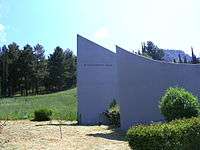Massacre of Kalavryta

The Massacre of Kalavryta (Greek: Σφαγή των Καλαβρύτων), or the Holocaust of Kalavryta (Ολοκαύτωμα των Καλαβρύτων), refers to the extermination of the male population and the total destruction of the town of Kalavryta, in Greece, by German occupying forces during World War II, on 13 December 1943.
In early December 1943, the German Army's 117th Jäger Division began a mission named Unternehmen Kalavryta (Operation Kalavryta), intending to encircle Greek Resistance guerilla fighters in the mountainous area surrounding Kalavryta. During the operation, 78 German soldiers, who had been taken prisoner by the guerrillas in October, were executed by their captors. In response, the commander of the German division, General Karl von Le Suire personally ordered the "severest measures" — the killing of the male population of Kalavryta — on 10 December 1943.
Operation Kalavryta was mounted from Patras and Aigion on the Gulf of Corinth and from near Tripolis in central Peloponnese. All "Battle-Groups" were aimed at Kalavryta. Wehrmacht troops burnt villages and monasteries and shot civilians on their way. When they reached the town they locked all women and children in the local school, set it afire from outside, and marched all males 12 and older to a hill just overlooking the town. There, the German troops machine-gunned them. There were only 13 male survivors. More than 500 died at Kalavryta. Survivors stated that when the Germans machine-gunned the crowd, they had been covered by the dead when they fell. The women and children managed to free themselves from the flaming school while the rest of the town was set ablaze. The following day the Nazi troops burned down the Agia Lavra monastery, a landmark of the Greek War of Independence.
In total, nearly 700 civilians were killed during the reprisals of Operation Kalavryta. Twenty-eight communities—towns, villages, monasteries and settlements—were destroyed. In Kalavryta itself about 1,000 houses were looted and burned, and more than 2,000 livestock seized by the Germans. The massacre was memorialized in the 2014 book, Hitler's Orphan: Demetri of Kalavrta by Marc Zirogiannis. This historical novella tells the story of the massacre from the perspective of the Zirogiannis family.[1]
Today the Place of Sacrifice is kept as a memorial site, and the events are commemorated every December. On 18 April 2000, then-President of the Federal Republic of Germany, Johannes Rau, visited Kalavryta to express his feelings of shame and deep sorrow for the tragedy.
In art
Requiem (1984) by Mikis Theodorakis is dedicated ”to the dead of the Massacre of Kalavryta”[2]
See also
- List of massacres in Greece
- War crimes of the Wehrmacht
- Krupki massacre
- Szczurowa massacre
- Distomo massacre
- Wehrmachtsausstellung
References
- ↑ Zirogiannis, Marc (24 May 2014). Hitler's Orphan: Demetri of Kalavryta (1st ed.). New York, NY: Lulu. p. 34. ISBN 9781312222595.
- ↑ "About Theodorakis's Requiem | "The Music of Mikis Theodorakis"". Theodorakisfriends.com. 2013-04-12. Retrieved 2016-11-06.
Sources
- Hermann Frank Meyer, Von Wien nach Kalavryta: Die blutige Spur der 117. Jäger-Division durch Serbien und Griechenland
- Andy Varlow, Just Another Man: A Story of the Nazi Massacre of Kalavryta. 1998; ISBN 1-883319-72-2
External links
- SOE, the Irish Agent and the Greek Massacre by Conal O'Donnell
- Book on the Kalavryta massacre written by a survivor
- Greek Government Information re. the Kalavryta massacre
- Museum of the Sacrifice of the People of Kalavryta
- Crimes of the German Wehrmacht
Coordinates: 38°2′N 22°7′E / 38.033°N 22.117°E